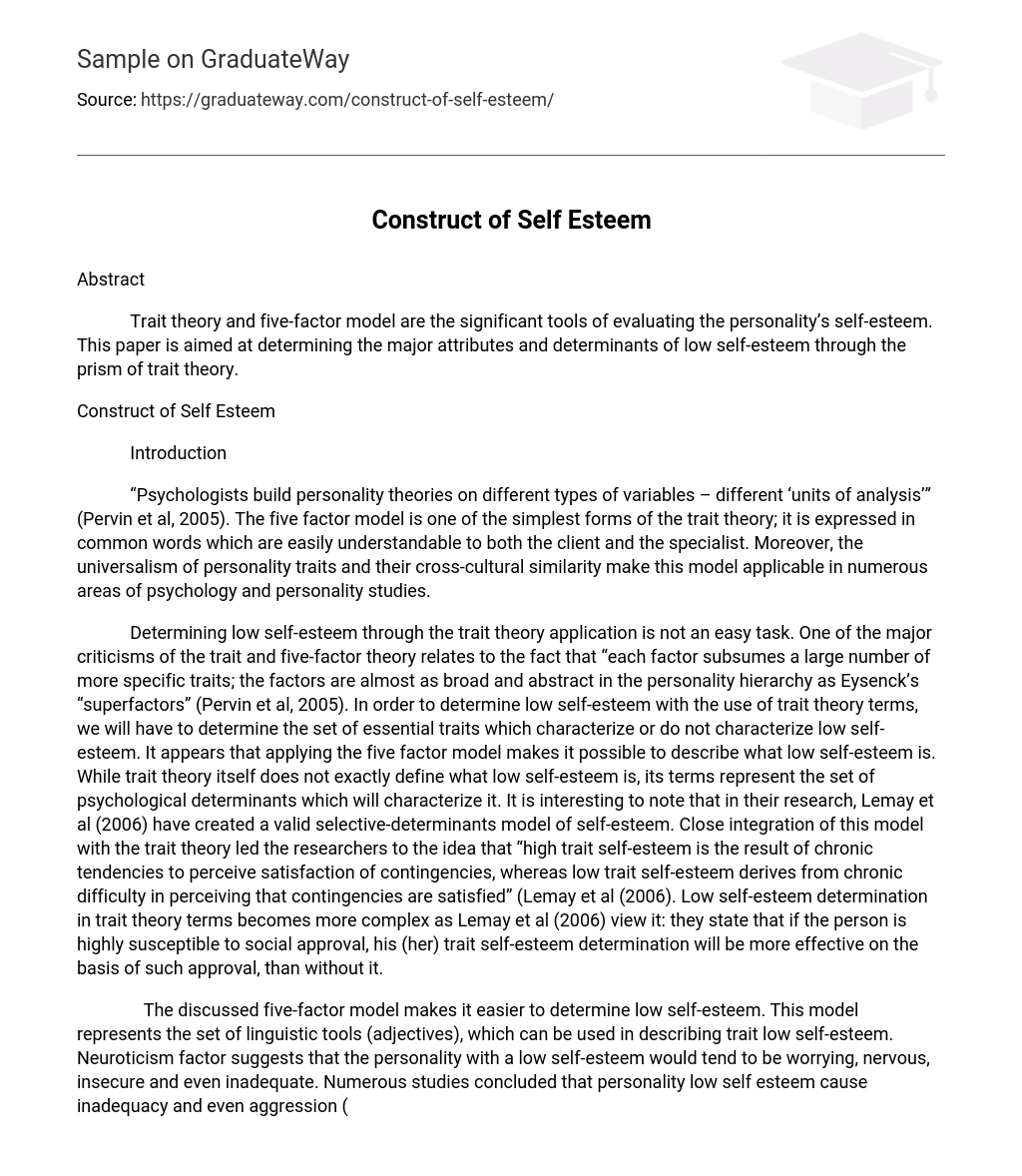Abstract
Trait theory and five-factor model are the significant tools of evaluating the personality’s self-esteem. This paper is aimed at determining the major attributes and determinants of low self-esteem through the prism of trait theory.
Construct of Self Esteem
Introduction
“Psychologists build personality theories on different types of variables – different ‘units of analysis’” (Pervin et al, 2005). The five factor model is one of the simplest forms of the trait theory; it is expressed in common words which are easily understandable to both the client and the specialist. Moreover, the universalism of personality traits and their cross-cultural similarity make this model applicable in numerous areas of psychology and personality studies.
Determining low self-esteem through the trait theory application is not an easy task. One of the major criticisms of the trait and five-factor theory relates to the fact that “each factor subsumes a large number of more specific traits; the factors are almost as broad and abstract in the personality hierarchy as Eysenck’s “superfactors” (Pervin et al, 2005). In order to determine low self-esteem with the use of trait theory terms, we will have to determine the set of essential traits which characterize or do not characterize low self-esteem. It appears that applying the five factor model makes it possible to describe what low self-esteem is. While trait theory itself does not exactly define what low self-esteem is, its terms represent the set of psychological determinants which will characterize it. It is interesting to note that in their research, Lemay et al (2006) have created a valid selective-determinants model of self-esteem. Close integration of this model with the trait theory led the researchers to the idea that “high trait self-esteem is the result of chronic tendencies to perceive satisfaction of contingencies, whereas low trait self-esteem derives from chronic difficulty in perceiving that contingencies are satisfied” (Lemay et al (2006). Low self-esteem determination in trait theory terms becomes more complex as Lemay et al (2006) view it: they state that if the person is highly susceptible to social approval, his (her) trait self-esteem determination will be more effective on the basis of such approval, than without it.
The discussed five-factor model makes it easier to determine low self-esteem. This model represents the set of linguistic tools (adjectives), which can be used in describing trait low self-esteem. Neuroticism factor suggests that the personality with a low self-esteem would tend to be worrying, nervous, insecure and even inadequate. Numerous studies concluded that personality low self esteem cause inadequacy and even aggression (Lemay et al, 2006). A person with low self esteem will likely display several of its low scorer characteristics through extraversion criterion – aloofness and task-orientation. The remaining three big factors (openness, agreeableness, and conscientiousness) suggest that the low self-esteem personality will be characterized with the following words: down-to-earth, having narrow interests, inartistic, cynical, rude, suspicious, irritable, aimless, unreliable, and weak-willed. The number of adjectives which trait theory offers to determine self-esteem is very large; this is why it is difficult and is almost impossible to create a general model of low self-esteem. On the contrary, when five factor model terms are applied to specific personality, it is possible to emphasize certain trait determinants. For example, “Costa and McCrae place the warmth facet on Extraversion whereas other Big Five researchers find that warmth is more closely related to Agreeableness” (Pervin et al, 2005). As a result, the terms of the five factor model are more applicable to analyzing specific personality, than creating generalized models of self-esteem (Lemay et al, 2006).
Conclusion
Trait theory does not directly define low self-esteem. It provides personality analytics with a valid model of universal linguistics determinants. It is rather difficult to generalize these attributes, because they create a better picture as applied to specific personality. There is still some disagreement upon the evaluation of some big-five adjectives, but trait theory remains an efficient tool of personality analysis.
References
Lemay, E.P. & Ashmore, R.D. (2006). The relationships of social approval contingency to
trait self-esteem: Cause, consequence, or moderator? Journal of Research in Personality 40, pp. 121-139.
Pervin, L., Cervone, D. & Oliver, J. (2005). Trait theory: The five factor model; evaluation of
trait approaches to personality. In L. Pervin, D. Cervone, and J. Oliver, Personality theory and research, 9th ed., John Wiley & Sons, pp. 262-272.





